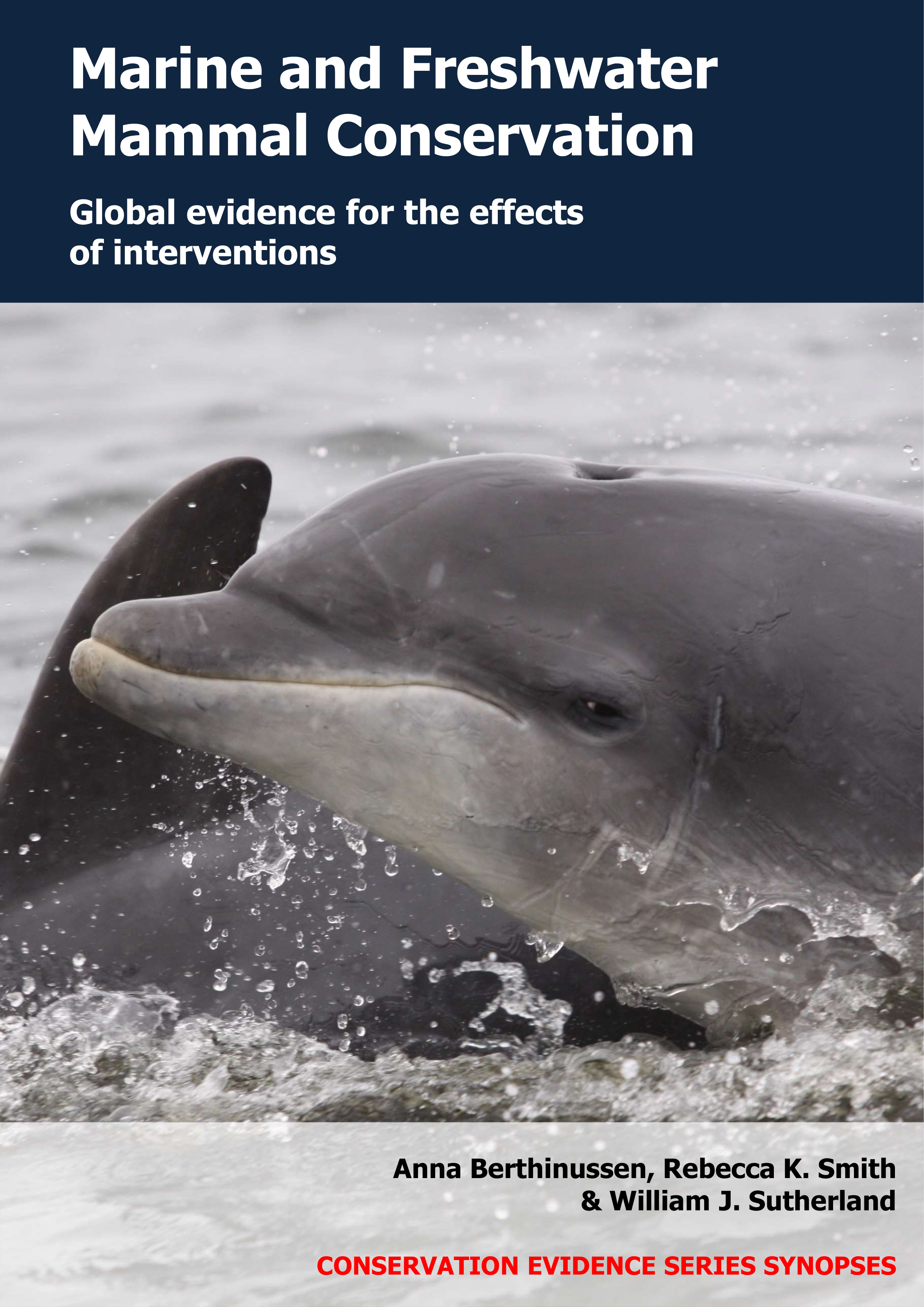Actions to conserve biodiversity
We have summarised evidence from the scientific literature about the effects of actions to conserve wildlife and ecosystems.
Review the evidence from the studies
Not sure what Actions are? Read a brief description.
Search for evidence
e.g. "frogs chytrid"
180 Actions found
Refine
Hide
180 Actions found
Download Actions
| 0 selected |
|
Order results by:
| Action | Effectiveness | Studies | Category | |
|---|---|---|---|---|
|
Vaccinate against disease Action Link |
No evidence found (no assessment) | 0 |
|
|
|
Use weakened fishing gear Action Link |
No evidence found (no assessment) | 0 |
|
|
|
Use volunteers to deter tourists from harassing marine and freshwater mammals at wildlife-viewing sites Action Link |
Likely to be beneficial | 1 |
|
|
|
Use stiffened materials or increase tension of fishing gear Action Link |
Unknown effectiveness (limited evidence) | 1 |
|
|
|
Use sinking lines instead of floating lines Action Link |
No evidence found (no assessment) | 0 |
|
|
|
Use remote tools to detect mammals in an area and allow vessel course or speed to be altered Action Link |
No evidence found (no assessment) | 0 |
|
|
|
Use real-time automated tools on board vessels to detect mammals and allow vessel course or speed to be altered Action Link |
No evidence found (no assessment) | 0 |
|
|
|
Use real-time automated tools at renewable energy sites to detect marine and freshwater mammals and allow operations to be stopped or modified Action Link |
No evidence found (no assessment) | 0 |
|
|
|
Use passive listening devices to detect mammals and prompt fishing vessels to move away Action Link |
No evidence found (no assessment) | 0 |
|
|
|
Use observers on board vessels to detect mammals and allow vessel course or speed to be altered Action Link |
No evidence found (no assessment) | 0 |
|
|
|
Use non-toxic antifouling coatings on surfaces Action Link |
No evidence found (no assessment) | 0 |
|
|
|
Use noise aversive conditioning to deter mammals from fishing gear Action Link |
Unknown effectiveness (limited evidence) | 1 |
|
|
|
Use methods to reduce sediment disturbance during dredging (e.g. curtains, screens) Action Link |
No evidence found (no assessment) | 0 |
|
|
|
Use methods to dampen underwater noise emissions (e.g. bubble curtains, screens) Action Link |
Unknown effectiveness (limited evidence) | 1 |
|
|
|
Use drugs to treat parasites Action Link |
Likely to be beneficial | 2 |
|
|
|
Use double hulls to prevent oil spills Action Link |
No evidence found (no assessment) | 0 |
|
|
|
Use different bait species for fishing that are less attractive to mammals Action Link |
No evidence found (no assessment) | 0 |
|
|
|
Use deterrents to reduce predation on marine and freshwater mammals by native species Action Link |
Unknown effectiveness (limited evidence) | 1 |
|
|
|
Use cooling towers instead of once-through cooling systems Action Link |
No evidence found (no assessment) | 0 |
|
|
|
Use catch and hook protection devices on fishing gear Action Link |
Likely to be beneficial | 5 |
|
|
|
Use biological control to manage invasive or problematic species Action Link |
No evidence found (no assessment) | 0 |
|
|
|
Use biodegradable fishing gear Action Link |
No evidence found (no assessment) | 0 |
|
|
|
Use biocides or other chemicals to control invasive or problematic species Action Link |
No evidence found (no assessment) | 0 |
|
|
|
Use bindings to keep trawl nets closed until they have sunk below the water surface Action Link |
No evidence found (no assessment) | 0 |
|
|
|
Use baited lines instead of nets for shark control Action Link |
Likely to be beneficial | 2 |
|
Download Actions
| 0 selected |
|

Marine and Freshwater Mammal Conservation - Published 2021
Marine and Freshwater Mammal Synopsis
Watch this search
If you are familiar with RSS feeds, please click the button below to retrieve the feed URL:
RSS feed for this searchIf you are unfamiliar with RSS feeds, we would suggest reading this BBC article.
Unfortunately, due to the number of feeds we have available, we cannot provide e-mail updates. However, you could use tools such as Feed My Inbox to do this for you.
What are 'Individual studies' and 'Actions'?
Individual studies
An individual study is a summary of a specific scientific study, usually taken from a scientific journal, but also from other resources such as reports. It tells you the background context, the action(s) taken and their consequences.
If you want more detail please look at the original reference.
Actions
Each action page focuses on a particular action you could take to benefit wildlife or ecosystems.
It contains brief (150-200 word) descriptions of relevant studies (context, action(s) taken and their consequences) and one or more key messages.
Key messages show the extent and main conclusions of the available evidence. Using links within key messages, you can look at the paragraphs describing each study to get more detail. Each paragraph allows you to assess the quality of the evidence and how relevant it is to your situation.
Where we found no evidence, we have been unable to assess whether or not an intervention is effective or has any harmful impacts.





)_2023.JPG)














